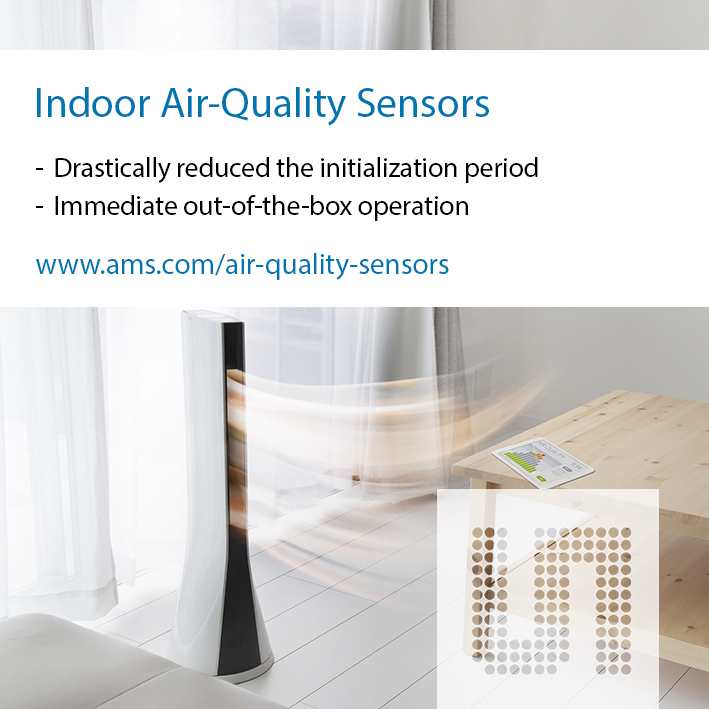Subscribe to EDOM TECH Newsletter
ams OSRAM
2018/07/18
ams CCS8xx product family of VOC sensors enhances end-user experience for indoor air-quality monitoring

ams (SIX: AMS), a leading worldwide supplier of high performance sensor solutions, has updated the functionality of its market-leading CCS8xx family of gas sensor ICs to reduce initialization time and improve performance in indoor air-quality monitoring applications.
Major upgrades to the software libraries of the CCS801, an analog volatile organic compound (VOC) sensor IC, and the device firmware for CCS811, a digital VOC sensor IC, have reduced the initialization period from more than 48 hours to 60 minutes. Now an indication of the indoor air quality level via a relative value for total VOC (TVOC) or equivalent CO2 (eCO2) can be used almost immediately after initial power-on in the end product.
This means that OEM customers can greatly reduce or even eliminate any burn-in process implemented at the factory and still provide end users with immediate out-of-the-box operation when integrated into an indoor air quality monitoring application.
These performance updates to the CCS8xx family also extend the air quality indication range as follows:
- The maximum eCO2 value has been raised from from 8,194ppm to 32,768ppm
- The maximum eTVOC value has been raised from 1,187ppb to 32,768ppb
This means CCS8xx sensors can operate in devices such as air cleaners and air purifiers intended for use in more polluted indoor environments.
The new software also gives users the flexibility to configure the clean air baseline value:
OEMs can now save and restore their own baseline values when the CCS8xx sensor is powered off and restarted in a polluted environment. In addition, the intervals between automatic baseline correction can be programmed by OEMs. These features ensure that the behavior of the sensor can be more closely matched with the characteristics of its intended operating environment.
The new software has been implemented on the existing hardware design of the CCS801 and CCS811, which are already widely used in home and building automation (HABA) applications. This robust hardware has been shipped in volume to many applications which have a product lifetime of ten years or more.
In parallel, ams has completed extensive testing of the CCS8xx product family when exposed to HDMS and D5, the most common siloxanes used in personal care and household cleaning products, to demonstrate their long-term reliability and high resistance to contamination by airborne siloxanes.
HMDS testing was performed in accordance with the ISO26142 standard. D5 testing involved exposure to a concentration of 250ppm for 200 hours. The tests indicate that CCS8xx sensors’ performance and relative sensitivity meet the tolerances allowable by all relevant standards. Therefore ams CCS8xx sensors continue to offer a reliable option for OEMs that require high resistance to siloxanes in typical indoor environments.
“According to the US Environmental Protection Agency, there is growing evidence that indoor air can be more polluted and expose to a greater health risk than outdoor air pollution,” said Paul Wilson, Senior Marketing Manager for environmental sensors at ams. “Since people spend on average 90% of their time indoors, there are enormous benefits both to health and comfort to the use of devices based on the CCS801 or CCS811 which monitor the air quality in the home, workplace or car.”
The CCS801 and CCS811 gas sensors are available now in production volumes. Evaluation kits are available.






